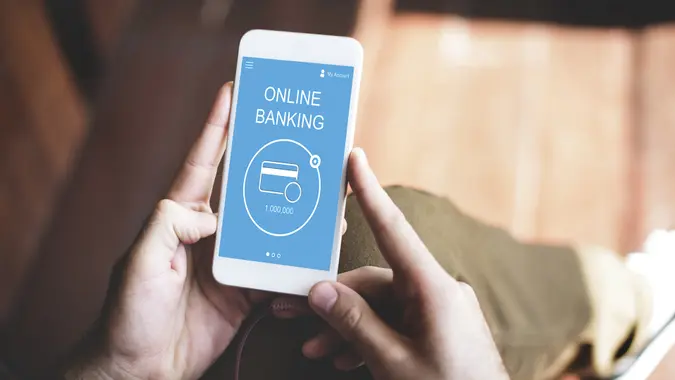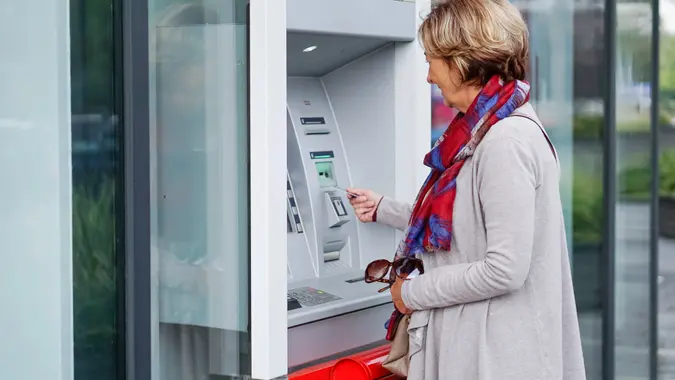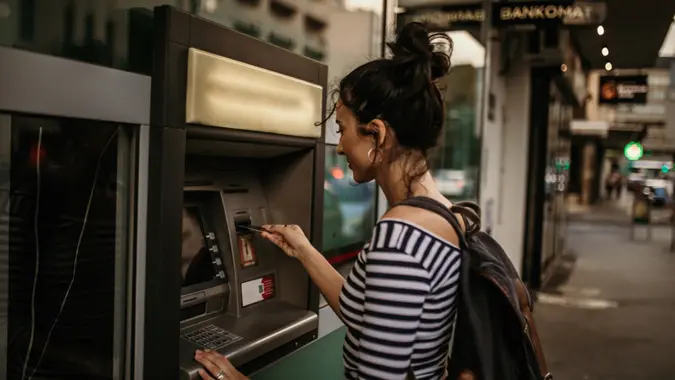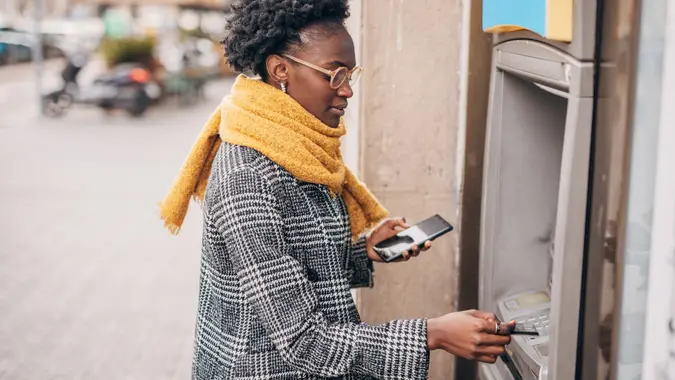What Our Banking Habits Say About the Financial State of America

Commitment to Our Readers
GOBankingRates' editorial team is committed to bringing you unbiased reviews and information. We use data-driven methodologies to evaluate financial products and services - our reviews and ratings are not influenced by advertisers. You can read more about our editorial guidelines and our products and services review methodology.

20 Years
Helping You Live Richer

Reviewed
by Experts

Trusted by
Millions of Readers
The economy might be humming along at a solid pace if you look at metrics like gross domestic product (GDP), but spending only tells part of the story. If you look at Americans’ banking habits, you can see that many people struggle to save money and face risks like overdrafting.
In a recent GOBankingRates survey, 60% said they keep $500 or less in their checking accounts, and 49% keep $500 or less in their savings. And this isn’t just a problem among young people. The numbers are similar for those ages 65 and older.
“These stats are alarming, because they show that a lot of people are just scraping by, without much saved up for emergencies,” said Jeff Rose, CFP and founder of Good Financial Cents.
With so many people not having much of a safety net, they often find themselves close to overdrafting. The survey found that 28% had an overdraft within the past year, and 22% have come close to overdrafting.
“Banks can really help here by providing tools and education on how to manage and save money. This could be through simple apps that help track spending, offering plans that prevent overdraft fees from stacking up, or giving tips on how to save a little bit of money in ways that don’t feel overwhelming,” said Rose.
Moving Toward Low Fees
The good news is that banks and credit unions have been trending toward getting rid of or minimizing overdraft fees, along with other fees, like monthly maintenance fees. But more could still be done to help Americans improve their financial habits. And there are still plenty of financial institutions with both overt and hidden fees, making it harder for some to get ahead.
Notably, low fees are by far the most important feature that Americans look for when opening a new account at a financial institution — 41% of respondents chose low fees, followed by 12% citing sign-up bonuses and slightly fewer responding that good rates are most important to them.
“Now that many banks have cut out fees, they need to find new ways to stand out. This could mean offering a really easy and useful online banking experience, tools for managing money better or even better rates for saving,” said Rose.
“Banks could also get creative, like giving you early access to your paycheck or rewarding you for saving money. It’s about offering something that not only keeps your money safe but also makes banking feel more personal and helpful,” he said.
Looking for Something Better
Although over three-quarters of Americans say they’re satisfied with all the products and services offered by their current financial institution, that doesn’t mean everyone is willing to stay put.
In fact, 35% of Americans have considered changing banks within the past year, and those ages 18-44 are even more likely to have considered switching: 42%-43% said they considered doing so, depending on age brackets within the larger 18-44 range.
These considerations could reflect the financial unsteadiness that many people feel, while also being a sign of the times we’re living in — many people have gotten used to the convenience of finding something better with a few clicks.
The number of young consumers considering changing banks doesn’t surprise Rose.
“Bank loyalty isn’t what it used to be,” he said. “This age group is tech-savvy and loves to keep their options open, often looking for what’s best for them. Banking, like shopping or streaming, has become a choice-driven market.”
Earning Trust
Changing financial institutions is more involved than hopping from one streaming platform to the next to look for something to watch. And the stakes are higher, too. Yet consumers aren’t hopping from bank to bank for the fun of it. Many feel distrustful of financial institutions.
Among consumers ages 18-24, nearly a quarter say they have very little trust or simply don’t trust their bank to act in their best interest. And it’s not as if the type of bank automatically makes a difference.
While 20% overall say they trust regional banks more than national banks, 12% say they don’t, and the most common answer was “I trust them the same,” followed by “It depends on the bank.”
So, financial institutions might have to do more to convince customers that they’re working for them, rather than relying on the type of organization they are.
“To convince more customers, particularly younger ones, that they act in their best interests, financial institutions must prioritize transparency by clearly communicating policies and fees,” said Cliff Ambrose, founder and wealth manager at Apex Wealth.
Here, too, better financial tools can help build customer trust while also helping people overcome the relatively low safety nets that many currently are dealing with.
Financial institutions “should offer personalized financial guidance and education, demonstrating a commitment to customer empowerment,” said Ambrose. “Responsive customer service and a dedication to ethical business practices, including social responsibility initiatives, are also essential.”
Little Account Variety
Lastly, it’s worth noting that many Americans only have checking and savings accounts. Other types of accounts, like certificates of deposit (CDs) and money market accounts, aren’t as popular. Yet considering that these often have attractive rates compared to other deposit accounts, it’s possible that financial institutions need to do a better job educating customers about how these work and their benefits, which could have the effect of helping people save more money while building loyalty.
As it stands, however, only 8% of respondents said they have a CD, while 9% said they have a money market account. In comparison, 83% have a savings account or high-yield savings account. Younger individuals are even less likely to own CDs or money market accounts.
Yet at the same time, slightly more than half of 18-24-year-olds keep over $500 in cash at home, which indicates more potential to earn interest if they can find an institution and account structure they’re comfortable with. For now, though, many Americans — especially younger ones — are missing out on higher interest rates, perhaps in part because of distrust or not having the right financial tools and literacy.
Survey methodology: GOBankingRates surveyed 1,063 Americans aged 18 and older from across the country between Nov. 27 and Nov. 29, 2023, asking twenty-two different questions: (1) What category best describes your current financial institution?; (2) Have you considered changing banks within the past year?; (3) If you have considered changing banks in the past year, were any of the following factors? (select all that apply); (4) Which feature, perk, or other offering is most important to you when opening an account with a new institution?; (5) Are you currently satisfied with all your banking products and services offered by your bank/credit union?; (6) Would you ever have different types of accounts across multiple banks? (i.e. checking at Chase, but savings at TD Bank); (7) What is your most preferred method of banking?; (8) Which of the following is the biggest factor of you staying with your current bank?; (9) Which of the following bank accounts do you currently use/have open? (Select all that apply); (10) How much is the minimum balance you keep in your checking account?; (11) How much do you currently have in your savings account?; (12) What amount of a sign up bonus would make you consider switching banks?; (13) Have you considered using any app-only banking platforms (aka neobanks) in the past year (e.g. Current, Chime, Dave, etc.); (14) How important is it to you for your bank to be affiliated with a crypto exchange/platform?; (15) In the past year, how often have you written a physical check?; (16) When was the last time you visited your bank in-person?; (17) Why would you choose to visit your bank in-person? (Select all that apply); (18) Have you had an overdraft on your checking account in the past year?; (19) How much do you trust your current bank to act in your best interest?; (20) How much do you trust your current bank to protect your private information?; (21) Do you trust regional banks more than national banks?; and (22) How much cash do you keep at home?. GOBankingRates used PureSpectrum’s survey platform to conduct the poll.
More From GOBankingRates
 Written by
Written by  Edited by
Edited by 



























